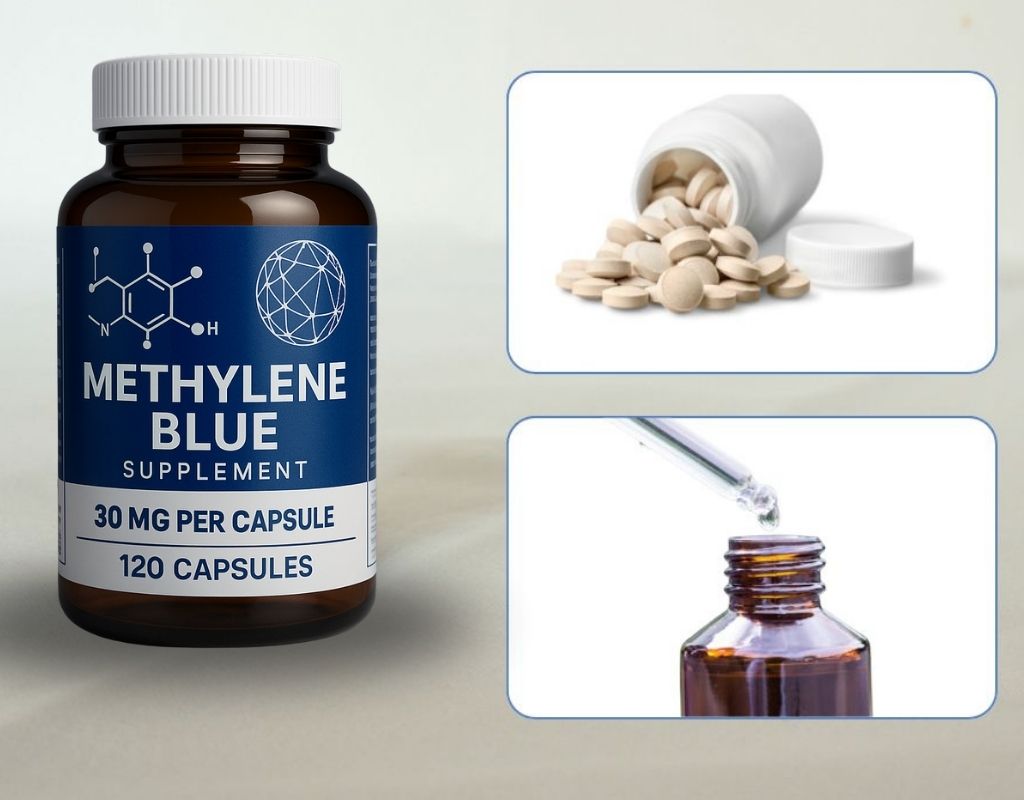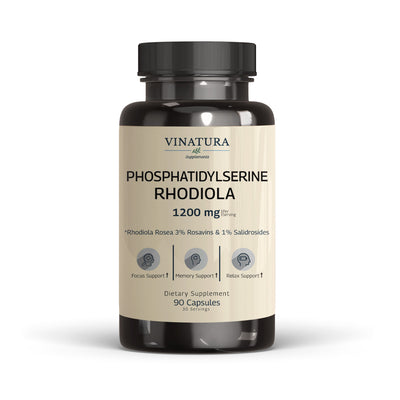
Methylene Blue Tablets vs Liquid: Which Form is Better?
Methylene Blue (MB) is gaining growing attention in the health community for its potential to enhance cellular energy, support cognitive function, and act as an antioxidant.
On the market today, MB is available in various forms, with capsules and liquid solutions being the most common. Each form differs significantly in terms of absorption, bioavailability, and convenience. So, which one should you choose for optimal results?
Before exploring further, please read the disclaimer located at the end of this webpage.
Key Takeaways
- Methylene Blue (MB) may support cellular energy, brain function, and antioxidant defense at low doses.
- Capsules offer fixed dosing and convenience, while liquid forms allow flexible adjustment but require careful handling.
- Liquid MB is more cost-effective long-term, though it may degrade faster if not stored properly.
- Choose based on your needs—capsules for ease and consistency, liquid for microdosing and fast absorption.
Overview: What Is Methylene Blue Used for in Supplements?

Methylene Blue (MB) is often promoted in supplements for its potential benefits in boosting cellular energy and providing antioxidant support for brain health.
The proposed mechanism involves supporting the mitochondrial electron transport chain, preserving ATP production, and scavenging harmful free electrons, thereby reducing oxidative stress [1].
At low doses, MB functions as a mitochondrial electron carrier, helping to reduce oxidative stress, enhance cellular respiration, and improve memory consolidation. This effect is linked to cytochrome oxidase activity and depends on neural network function.
MB exhibits a hormetic response: beneficial at low doses, harmful at high doses. This makes MB a promising compound for further research in the area of cognitive aging and mitochondrial health (Rojas, Bruchey, & Gonzalez-Lima, 2012).
Several preclinical studies suggest that low-dose MB may enhance memory and learning performance in laboratory mice [2].
“Methylene blue (MB) is a metabolic enhancer that has been demonstrated to improve memory retention when given post-training in low doses in a variety of tasks in rats, including inhibitory avoidance, spatial memory (in both normal and metabolically-impaired subjects), object recognition, and habituation to a familiar environment.”
- The Brain Metabolic Enhancer Methylene Blue Improves Discrimination Learning in Rats (Wrubel et al., 2007)
In summary, while low-dose MB has shown promising effects in preclinical studies, more robust clinical trials in humans are needed to determine its safety and efficacy for brain health.
Methylene Blue Tablets Vs Liquid: Key Differences
On the market, Methylene Blue (MB) is primarily available in two forms: capsules and liquid solutions.
|
Characteristic |
Capsules/Tablets |
Liquid |
|
Dosage |
Fixed amount per capsule. |
Easily adjustable by counting drops or measuring volume. |
|
Convenience |
Easy to carry, mess-free, no staining. |
Can be taken orally or sublingually but prone to spilling. |
|
Taste & Color |
Usually tasteless and does not stain. |
Often bitter or medicinal; characteristic deep blue color. |
|
Absorption |
Requires disintegration in the stomach; stable during storage. |
May absorb faster (no need for disintegration); sensitive to light and temperature. |
Capsules offer convenience and accurate dosing, while liquid forms provide more flexibility in dose adjustment but are less stable and harder to transport. The following sections explore these differences in more detail.
Absorption and Bioavailability: Does Form Affect Effectiveness?
In theory, liquid Methylene Blue may absorb faster than capsules/tablets since it bypasses the disintegration process required for solid forms. It can also be taken sublingually for potentially quicker entry into the bloodstream.
However, actual effectiveness depends on several factors: dosage, product purity and quality, and how it's consumed (e.g., with or without food). Currently, there's no definitive clinical evidence proving a clear absorption advantage between the two forms—this remains a general assumption.
Convenience and Dosing Precision
Capsules/Tablets: Each capsule contains a fixed amount of MB, making it easier to control the dose. Experts note that capsules help users ensure they're taking the exact number of milligrams needed.
Liquid: Offers flexible dosing (e.g., 1–2 drops as desired), but accuracy can be an issue if not carefully measured.
Users often report that counting drops is tricky due to varying drop sizes and may require shaking the bottle multiple times to reach the intended dose. Some products include calibrated droppers, but accurate dosing still depends on proper technique and bottle positioning.*

Shelf Life, Storage, and Stability
Capsules/Tablets: Generally more stable and less likely to lose potency over time. Capsules protect MB from air and light, which extends shelf life. When stored at room temperature, capsules maintain their stability effectively.
Liquid: MB solution is more sensitive to storage conditions. High temperatures, direct sunlight, or exposure to air can reduce its potency. It’s recommended to store MB in a cool place (20–25°C) and away from direct sunlight.
- Storage Tips for MB:
- Avoid direct sunlight.
- Keep the container sealed in a cool, dry place.
- Avoid high heat and freezing.
- Keep the bottle intact and closed when not in use.

Cost Comparison and Value for Money
|
Product Type |
Volume / Count |
Concentration |
Avg. Price |
Price per 10mg MB |
|
Liquid (1%) |
60ml (600mg MB) |
10mg/ml |
~$20 USD |
~$0.33 USD |
|
Capsules/Tablets |
110 capsules (~1100mg MB) |
~10mg/capsule |
~$65 USD |
~$0.59 USD |
Note: Average prices based on trusted, popular products (USP Grade, formaldehyde-free) on Amazon as of June 2025.
Long-Term Use Cost Insight:
- Liquid MB is clearly more economical, with a cost of around $0.33 USD per 10mg dose—roughly 44% cheaper than capsules.
Assuming a daily dose of 10mg (equivalent to 1ml of 1% solution):
- Liquid: ~ $10/month
- Capsules/Tablets: ~ $18/month
While capsules are convenient and easy to dose, they carry a significantly higher long-term cost.
Summary Table: Capsule vs. Liquid
|
Criteria |
Liquid |
Capsules/Tablets |
|
Cost per Dose |
Lower (~$0.33 USD) |
Higher (~$0.59 USD) |
|
Portability |
Requires measuring dose |
Easy to use and carry |
|
Dosing Flexibility |
Flexible (drop-based) |
Less flexible (fixed dose) |
|
Contamination Control |
Widely tested (varies) |
Depends on manufacturer |
Conclusion: Which One Is Right for You?
Both Methylene Blue forms—capsules and liquid—have their own advantages, and the best choice depends on your goals and lifestyle:
- Capsules/Tablets: A great choice for beginners or those who prefer convenience, consistent dosing, and less risk of mess or staining compared to the blue liquid form.
- Liquid: Best suited for experienced users who want flexible dosing, faster onset, or microdosing capabilities.
Whichever form you choose, prioritize products with high purity (USP/pharma grade), free from harmful impurities like formaldehyde, and from reputable brands with third-party testing. It’s strongly recommended to consult a medical professional, nutrition expert, or trusted provider before using MB regularly or combining it with other medications.
Testimonial Disclaimer
*The testimonials presented on this website are provided by individuals based on their personal experiences with our products. These testimonials represent individual opinions and experiences, which may not be typical or applicable to all users of our products. Results may vary depending on a variety of factors, including individual health, lifestyle, and adherence to product usage instructions.References
- [1] Rojas JC, Bruchey AK, F. Gonzalez-Lima. Neurometabolic mechanisms for memory enhancement and neuroprotection of methylene blue. Progress in Neurobiology. 2011;96(1):32-45. doi:https://doi.org/10.1016/j.pneurobio.2011.10.007
- [2] Wrubel KM, Riha PD, Maldonado MA, McCollum D, F. Gonzalez-Lima. The brain metabolic enhancer methylene blue improves discrimination learning in rats. Pharmacology Biochemistry and Behavior. 2007;86(4):712-717. doi:https://doi.org/10.1016/j.pbb.2007.02.018
Author

Product Disclaimer
Including an ingredient or study does not evaluate, endorse, or recommend any Vinatura product or any third-party product. Some ingredients discussed may not be used in any Vinatura product.
The content of the articles has not been evaluated by the Food and Drug Administration (FDA) and is not intended to promote or endorse any specific product. Any products sold on this website are not intended to diagnose, treat, cure, or prevent any disease.
Opinions and Endorsements
Any claims, statements, or opinions expressed in the articles are those of the author(s) and do not necessarily reflect the views or opinions of the manufacturers of the dietary supplement products. The products sold on this website are separate from the content of the articles and are not directly endorsed or associated with the information presented here.
Liability Disclaimer
The author(s) of the articles, website, and manufacturers of the dietary supplement products do not assume any liability for any potential consequences arising from the use of the information provided in the articles. Ingredient effects, dosages, and safety vary by individual, formulation, and context; some ingredients interact with medications or may be unsuitable during pregnancy or lactation. It is recommended that individuals consult with a qualified healthcare professional before making any dietary or lifestyle changes, including the use of dietary supplements.
Product Usage
Please refer to the product labels and packaging for specific usage instructions and guidelines for the dietary supplement products sold on this website.
Customer Support
For any concerns or questions regarding the dietary supplement products, please contact our customer support team, who will be more than happy to assist you.





Leave a Comment
Be the first to comment.
What do you think?